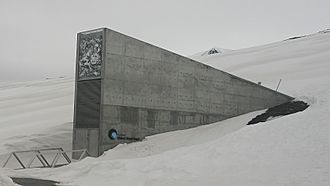Svalbard Global Seed Vault facts for kids
Quick facts for kids Svalbard Global Seed Vault |
|
|---|---|
|
Svalbard globale frøhvelv
|
|
 |
|
| General information | |
| Status | Complete |
| Type | Seed bank |
| Location | Spitsbergen |
| Town or city | Longyearbyen |
| Country | Norway |
| Coordinates | 78°14′09″N 15°29′29″E / 78.235867°N 15.491374°E |
| Elevation | 130 m (430 ft) |
| Groundbreaking | 19 June 2006 |
| Opened | 26 February 2008 |
| Cost | 45 million kr (US$8.8 million, 2008) |
| Technical details | |
| Floor count | 1 |
| Floor area | c. 1,000 m2 (c. 11,000 sq ft) |
| Awards and prizes | Norwegian Lighting Prize for 2009 No. 6 TIME's Best Inventions of 2008 |
The Svalbard Global Seed Vault is a special place in Norway where plant seeds are kept safe. It is like a huge bank for seeds. This vault is on the island of Spitsbergen, close to Longyearbyen. This area is part of the Arctic Svalbard archipelago. It is about 1,300 kilometers (800 miles) from the North Pole.
A person named Cary Fowler, who works to protect nature, helped start this vault. He worked with a group called the Consultative Group on International Agricultural Research (CGIAR). The main goal of the vault is to save many different types of plant seeds.
The seeds stored here are copies of seeds from other places around the world. These copies are kept safe in case the original seeds are lost due to disasters or other problems. Three groups work together to manage the vault. These are the Norwegian government, the Global Crop Diversity Trust (GCDT), and the Nordic Genetic Resource Center (NordGen).
The Norwegian government paid for building the vault. It cost about 45 million Norwegian kroner, which was about 9 million US dollars in 2008. Storing seeds in the vault is free for countries and organizations. Norway and the GCDT pay for the vault to keep running. The GCDT gets money from groups like the Bill & Melinda Gates Foundation and from different governments worldwide.
Contents
Why We Need the Seed Vault
The Svalbard Global Seed Vault is very important for the future of food. It helps protect the world's plant diversity. This means it keeps many different kinds of plants safe.
Protecting Our Food Supply
Imagine if a natural disaster, like a big flood or a long drought, destroyed all the crops in one part of the world. Or what if a new plant disease wiped out a certain type of crop? The Seed Vault helps prevent a total loss. It holds backup copies of seeds. These copies can be used to regrow plants if the original ones are lost.
Saving Plant Diversity
There are thousands of different kinds of plants on Earth. Each one has unique features. Some plants might be good at growing in dry places. Others might be strong against certain diseases. If we lose these different types of plants, we lose their special features forever. The vault helps save this important variety.
How the Vault Works
The vault is built deep inside a mountain. This location helps keep the seeds safe and cold.
Location and Structure
The vault is built into a sandstone mountain on Spitsbergen island. It is about 130 meters (426 feet) above sea level. This high location means it will stay dry even if sea levels rise. The vault has thick walls and special security systems. It is designed to last for a very long time.
Keeping Seeds Cold
The vault is naturally cold because it is in the Arctic. The permafrost, which is ground that is always frozen, helps keep the vault at a steady temperature. The seeds are stored at a very cold temperature, around -18 degrees Celsius (0 degrees Fahrenheit). This cold temperature helps the seeds stay alive and healthy for many years.
Seed Storage Process
When seeds arrive at the vault, they are carefully prepared.
- Seeds are cleaned and dried.
- They are sealed in special three-ply foil packages.
- These packages are then placed into large plastic boxes.
- The boxes are stored on shelves inside the cold vault chambers.
Each country or organization that sends seeds still owns their seeds. The vault just provides a safe storage place. This means countries can ask for their seeds back if they need them.
Images for kids
See also
 In Spanish: Banco Mundial de Semillas de Svalbard para niños
In Spanish: Banco Mundial de Semillas de Svalbard para niños



